|
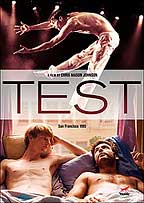
Test
Wolfe Video,
2013
Director/Screenplay:
Chris Mason Johnson
Starring;
Scott Marlowe,
Matthew Risch,
Evan Boomer,
Kevin Clarke,
Kristoffer Cusick,
Damon K. Sperber,
Katherine Wells,
Sergio Benvindo.
Andre Mathieu
Unrated, 89 minutes
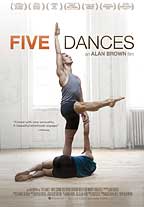
Five Dances
Wolfe Video,
2013
Director/Screenplay:
Alan Brown
Starring;
Ryan Steele,
Reed Luplau,
Catherine Miller,
Kimiye Corwin,
Luke Mutrphy
Unrated, 83 minutes |
Dancing With Myself
by
Michael D. Klemm
Posted online September, 2014
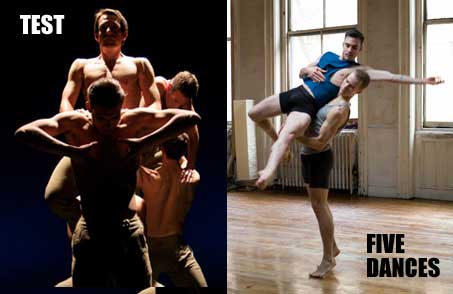
I’d like to discuss two enjoyable queer films that, despite divergent plots, share several similarities. Test and Five Dances (both released in 2013) take place within the world of modern dance. Each is centered around a young gay protagonist and a possible love story that the characters “dance around” until the film is almost over. Both feature exceptional photography of stunning dance numbers, and each ends so abruptly that you almost wonder if the director ran out of film.
TEST |
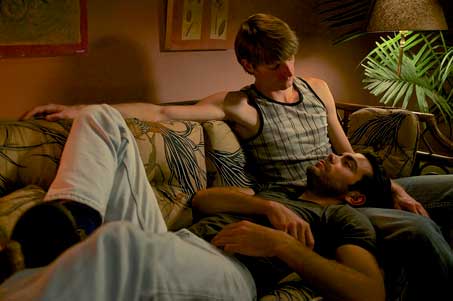 |
|
Test, the stronger of the two, is the second feature film from writer/director Chris Mason Johnson (The New Twenty). The setting is San Francisco in 1985 and it is a scary time to be gay. A lot still wasn’t known about the AIDS virus, and gay men were learning about using condoms. The first HIV test had just become available and with that came the fear of knowing your status. After summoning up the courage to take the test, you also had to wait two nerve-wracking weeks for the results. |
 Frankie (Scott Marlowe), the film’s anxious test subject, is used to waiting. He is the understudy for a small dance troupe, patiently hoping for the day when he can strut his stuff on stage and not just in the rehearsal hall. Their show is called “After Dark” and all the men dance shirtless. Most of the male dancers are gay but that doesn’t mean that homophobia within the company is nonexistent. Perhaps effeminatetophobia might be more accurate (even if there is no such word). When the choreographer berates Frankie’s dancing, he growls, “I don’t care who you fuck, I care how you dance. Dance like a fucking man!” Several of the others give him tips on how to “butch it up” and look “less gay” when performing because “no one wants to watch a guy dance like a girl.” Frankie (Scott Marlowe), the film’s anxious test subject, is used to waiting. He is the understudy for a small dance troupe, patiently hoping for the day when he can strut his stuff on stage and not just in the rehearsal hall. Their show is called “After Dark” and all the men dance shirtless. Most of the male dancers are gay but that doesn’t mean that homophobia within the company is nonexistent. Perhaps effeminatetophobia might be more accurate (even if there is no such word). When the choreographer berates Frankie’s dancing, he growls, “I don’t care who you fuck, I care how you dance. Dance like a fucking man!” Several of the others give him tips on how to “butch it up” and look “less gay” when performing because “no one wants to watch a guy dance like a girl.”
|
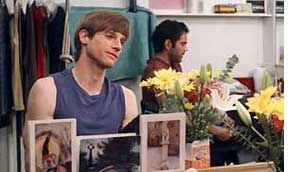 The film’s opening scene establishes a love-hate relationship between two of the troupe’s dancers. Frankie locks horns with the free spirited Todd (Matthew Risch). A self-proclaimed “slut,” Todd talks brazenly about his sexual exploits and pisses Frankie off when he muses aloud about maybe having sex for money. In the tradition of classic screwball comedies (think when Cary Grant and Rosalind Russell first meet in His Girl Friday), you know instinctively that their mutual dislike won’t last and that these men are really made for each other. Half the fun is always watching how such opposites will eventually attract before the movie is over. The film’s opening scene establishes a love-hate relationship between two of the troupe’s dancers. Frankie locks horns with the free spirited Todd (Matthew Risch). A self-proclaimed “slut,” Todd talks brazenly about his sexual exploits and pisses Frankie off when he muses aloud about maybe having sex for money. In the tradition of classic screwball comedies (think when Cary Grant and Rosalind Russell first meet in His Girl Friday), you know instinctively that their mutual dislike won’t last and that these men are really made for each other. Half the fun is always watching how such opposites will eventually attract before the movie is over.
|
 It would have been easy to just make this a fluffy romance, but director Johnson gives the film weight by setting it during a period when everything about being gay was turned upside down. AIDS was the big game changer. A generation of gay men who had embraced sexual liberation was now wondering if the disease was going to create a new wave of monogamy. Trying to use condoms for the first time seems “antiquated” and, when the mood gets killed, Frankie laments that “these things are going to end sex forever.” It would have been easy to just make this a fluffy romance, but director Johnson gives the film weight by setting it during a period when everything about being gay was turned upside down. AIDS was the big game changer. A generation of gay men who had embraced sexual liberation was now wondering if the disease was going to create a new wave of monogamy. Trying to use condoms for the first time seems “antiquated” and, when the mood gets killed, Frankie laments that “these things are going to end sex forever.”
|
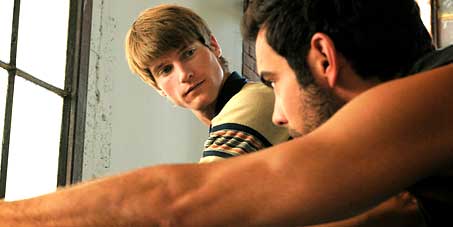 |
Test gets a lot of details right, especially the early confusion and paranoia about the AIDS virus. There is a striking scene, set during a rehearsal, in which one of the women refuses to keep dancing with Todd until he towels off his sweat. Another talks about not eating in the Castro anymore because she thinks it might be in the food. Frankie – and some of the other dancers – are seen checking every mole and blemish on their bodies to make sure it’s not a Kaposi lesion. When the HIV test becomes available, they are afraid to take it. The test results are supposed to be confidential, but what if your name ends up on a list? They often speak in hushed tones and the actors do a good job conveying their fear. Much of this is in shorthand, but it feels right and the needed information is presented without hitting the audience over the head. |
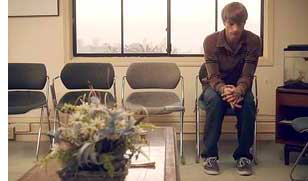 Now and then we are given reasons to think that Frankie might be sick. He complains to a doctor about dizzy spells, and we watch him stumble down a hill on the way to work. Later he finds a message on his answering machine from a man he tricked with – who tells him that he just tested positive. “If you get sick,” Todd tells Frankie, “that’s how your family finds out. You come out by dying.” Now and then we are given reasons to think that Frankie might be sick. He complains to a doctor about dizzy spells, and we watch him stumble down a hill on the way to work. Later he finds a message on his answering machine from a man he tricked with – who tells him that he just tested positive. “If you get sick,” Todd tells Frankie, “that’s how your family finds out. You come out by dying.”
|
 A few ugly instances of homophobia are also included. A discarded mattress on the street is spray painted with the slogan: “AIDS Faggot Die,” and a cab driver who drives Frankie and Todd to a gay bar asks them why they want to mingle with such “human garbage.” While riding the bus, Frankie sees a newspaper headline that asks if gays should be quarantined. Internalized homophobia also appears to be an issue when Frankie’s (seemingly gay) roommate apparently reverts back into the closet and moves in with a girl friend. A few ugly instances of homophobia are also included. A discarded mattress on the street is spray painted with the slogan: “AIDS Faggot Die,” and a cab driver who drives Frankie and Todd to a gay bar asks them why they want to mingle with such “human garbage.” While riding the bus, Frankie sees a newspaper headline that asks if gays should be quarantined. Internalized homophobia also appears to be an issue when Frankie’s (seemingly gay) roommate apparently reverts back into the closet and moves in with a girl friend.
|
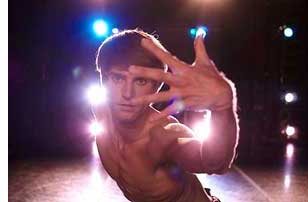 The era is evoked in small strokes. The dancers smoke cigarettes backstage and in bars. Frankie has bought one of the first Walkmans and always listens to music in headphones. In these pre-cellphone days, he continually wrestles with a tangled phone cord. The soundtrack hits the right notes with period tunes like Sylvester’s “You Make Me Feel” and “Small Time Boy” by Bronski Beat. And – while Frankie waits for his HIV test results – he hears about actor Rock Hudson’s illness and then his death from AIDS complications. The era is evoked in small strokes. The dancers smoke cigarettes backstage and in bars. Frankie has bought one of the first Walkmans and always listens to music in headphones. In these pre-cellphone days, he continually wrestles with a tangled phone cord. The soundtrack hits the right notes with period tunes like Sylvester’s “You Make Me Feel” and “Small Time Boy” by Bronski Beat. And – while Frankie waits for his HIV test results – he hears about actor Rock Hudson’s illness and then his death from AIDS complications.
|
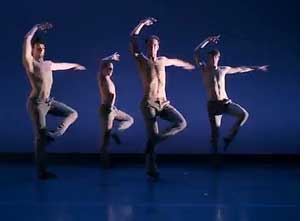 Director Johnson was once a dancer and the dance sequences are a major part of the film. Choreographed by Sidra Bell, the Artistic Director of Sidra Bell Dance NY, the dancing is both athletic and sensual. The lighting on the men’s sculpted torsos is stark and dramatic. The camera is always in the right spot (often not the case in movies), the rhythms created by the editing are fluid. Both Marlowe and Risch are professional dancers and their movements – along with the rest of the troupe - are exquisite. Marlow performs with San Francisco’s LEVY Dance and Risch created the role of Carlos in Legally Blonde: The Musical on Broadway. Director Johnson was once a dancer and the dance sequences are a major part of the film. Choreographed by Sidra Bell, the Artistic Director of Sidra Bell Dance NY, the dancing is both athletic and sensual. The lighting on the men’s sculpted torsos is stark and dramatic. The camera is always in the right spot (often not the case in movies), the rhythms created by the editing are fluid. Both Marlowe and Risch are professional dancers and their movements – along with the rest of the troupe - are exquisite. Marlow performs with San Francisco’s LEVY Dance and Risch created the role of Carlos in Legally Blonde: The Musical on Broadway.
|
 You’re not put through the wringer like the recent HBO film of Larry Kramer’s The Normal Heart (which some reviewers are unfairly comparing Test with – even though the stories are vastly different). There is no outright horror, just a prevailing sense of paranoia while life goes on in spite of it. A good part of Test is funny even while the characters are taking steps to take responsibility for their HIV status. In the end, Frankie calls Todd and says “Fuck art, let’s dance” and, for a change, a story set in the 80s ends happily. There’s something in this film for everyone - especially if you love dance. Elements of the story might seem familiar but, until there is a definitive cure for AIDS, films like this will always be important. You’re not put through the wringer like the recent HBO film of Larry Kramer’s The Normal Heart (which some reviewers are unfairly comparing Test with – even though the stories are vastly different). There is no outright horror, just a prevailing sense of paranoia while life goes on in spite of it. A good part of Test is funny even while the characters are taking steps to take responsibility for their HIV status. In the end, Frankie calls Todd and says “Fuck art, let’s dance” and, for a change, a story set in the 80s ends happily. There’s something in this film for everyone - especially if you love dance. Elements of the story might seem familiar but, until there is a definitive cure for AIDS, films like this will always be important.
FIVE DANCES |
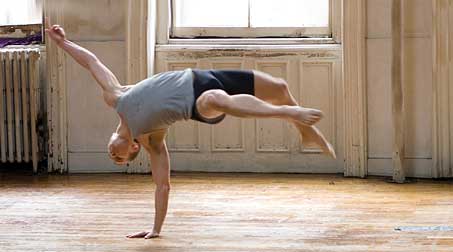 |
The dance is even more prominent in Five Dances from writer/director Alan Brown (Private Romeo). Broadway dance sensation Ryan Steele (Newsies) plays Chip, an 18-year old kid from Kansas, who is in New York City on a Joffrey program scholarship. He is part of a small dance company that is rehearsing a complex piece for the opening night of an arts festival. It’s Chip’s first gig in the Big Apple and he will be performing a lengthy solo – if he can keep his mind focused on his work. |
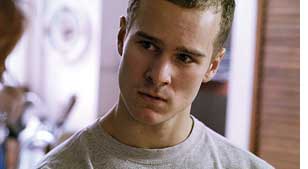 There are many distractions in his life. For starters, he’s homeless and sleeping in the dance studio after everyone leaves. His drunken mother keeps calling and ordering him to come back home and take care of her. “I know what you’re doing and I don’t like it!” she shrieks. We will learn that Chip is gay and that he is still very much in the closet – parental disapproval undoubtedly being one of the reasons why. Which brings us to the third distraction. Theo (Reed Luplau), the company’s other male dancer, is also gay. He is clearly attracted to Chip and the two men will dance around that attraction for the remainder of the film. There are many distractions in his life. For starters, he’s homeless and sleeping in the dance studio after everyone leaves. His drunken mother keeps calling and ordering him to come back home and take care of her. “I know what you’re doing and I don’t like it!” she shrieks. We will learn that Chip is gay and that he is still very much in the closet – parental disapproval undoubtedly being one of the reasons why. Which brings us to the third distraction. Theo (Reed Luplau), the company’s other male dancer, is also gay. He is clearly attracted to Chip and the two men will dance around that attraction for the remainder of the film.
|
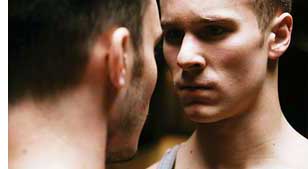 There is the potential for a lot of drama amongst the dance company but it never fully erupts. The choreographer (who is also dancing with them as well) sleeps with the married dancer and, aside from one tense flare-up during a rehearsal, this never comes up again. There is clear sexual tension between Chip and Theo, especially when they dance together. Chip will violently push Theo away when he first makes a pass at him and, yet, such a dramatic scene never catches fire. The cast members express themselves far more eloquently when they are dancing than when they are speaking and perhaps this was the director’s point. At least a third of Five Dances is devoted to the dance and it is these sequences that are the most captivating in the film. There is the potential for a lot of drama amongst the dance company but it never fully erupts. The choreographer (who is also dancing with them as well) sleeps with the married dancer and, aside from one tense flare-up during a rehearsal, this never comes up again. There is clear sexual tension between Chip and Theo, especially when they dance together. Chip will violently push Theo away when he first makes a pass at him and, yet, such a dramatic scene never catches fire. The cast members express themselves far more eloquently when they are dancing than when they are speaking and perhaps this was the director’s point. At least a third of Five Dances is devoted to the dance and it is these sequences that are the most captivating in the film.
|
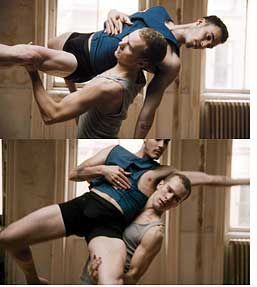 The outstanding choreography by the internationally renowned Jonah Bokaer is inventive and sensual. I still have nothing but praise for the well-shot dance interludes in Test, but the dance scenes in Five Dances reach even greater heights. Five Dances begins with a bravura solo dance number by Chip that lasts over four minutes and it is a lovely overture to the film. The dance is exquisite and the camera catches every nuance. There are long takes and, whenever the shot changes, the cutting on movement is flowing and flawless. The camera is always exactly where it needs to be. The director knows when to move the camera, when to pull back, when to zoom in closer, when to circle around a sweating dancer’s head, when to cut. Choreography and cinematography are happily married throughout all of the film’s many dance scenes and the effect is breathtaking. In one stunning instance, one scene turns into another in the middle of the same fluid dance movement. The outstanding choreography by the internationally renowned Jonah Bokaer is inventive and sensual. I still have nothing but praise for the well-shot dance interludes in Test, but the dance scenes in Five Dances reach even greater heights. Five Dances begins with a bravura solo dance number by Chip that lasts over four minutes and it is a lovely overture to the film. The dance is exquisite and the camera catches every nuance. There are long takes and, whenever the shot changes, the cutting on movement is flowing and flawless. The camera is always exactly where it needs to be. The director knows when to move the camera, when to pull back, when to zoom in closer, when to circle around a sweating dancer’s head, when to cut. Choreography and cinematography are happily married throughout all of the film’s many dance scenes and the effect is breathtaking. In one stunning instance, one scene turns into another in the middle of the same fluid dance movement.
|
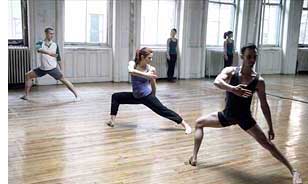 While they dance, we are immersed in their world. There is often no music; sometimes you just hear the sound of the floorboards creaking… the swish of their rehearsal clothes… the sound of their feet sliding on the polished floor. At one point there is only the sound of heavy breathing while Chip and Theo dance alone together in dark studio after everyone else has gone home. The music is usually understated; quiet piano or cello. However, there are a few “songs” that they danced to and these were major distractions. The vocals took me right out of the movie – try as hard as you can to not listen to the lyrics. While they dance, we are immersed in their world. There is often no music; sometimes you just hear the sound of the floorboards creaking… the swish of their rehearsal clothes… the sound of their feet sliding on the polished floor. At one point there is only the sound of heavy breathing while Chip and Theo dance alone together in dark studio after everyone else has gone home. The music is usually understated; quiet piano or cello. However, there are a few “songs” that they danced to and these were major distractions. The vocals took me right out of the movie – try as hard as you can to not listen to the lyrics.
|
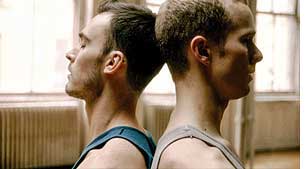 While I loved the exquisite dance numbers, I found the rest of the film rather cold. Chip’s character is barely a cipher, and his interactions with Theo are all over the place. The path from gay panic to lovesick puppy dog seems to skip a few steps. I liked that Five Dances isn’t the usual paint by numbers love story, but I never became emotionally invested in the characters. The film delivers the expected payoffs; it goes without saying that there will eventually be a lovemaking scene that will be photographed with the same passion as the dance numbers. While I loved the exquisite dance numbers, I found the rest of the film rather cold. Chip’s character is barely a cipher, and his interactions with Theo are all over the place. The path from gay panic to lovesick puppy dog seems to skip a few steps. I liked that Five Dances isn’t the usual paint by numbers love story, but I never became emotionally invested in the characters. The film delivers the expected payoffs; it goes without saying that there will eventually be a lovemaking scene that will be photographed with the same passion as the dance numbers.
|
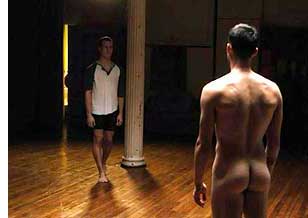 Here’s something worth mentioning – about this film and the entire queer film genre in general. Early in the film, Katie (Catherine Miller), one of the other dancers, finds Chip sleeping in the studio and lets him stay at her place. When she “casually” mentions that she just broke up with her boyfriend, we know where this would be headed in a straight movie and this brings up something that can be a problem in queer films. Because Five Dances is marketed towards a gay audience, we take it for granted that our main character is gay. But, let’s remove the queer label. Chip’s sexuality is never stated in the beginning. If we didn’t assume that he was queer from the get-go, there would be different expectations and this would be a different film when he goes home with Katie. The revelation of his real sexual identity, later on, would be a plot surprise. And perhaps add a bit more much needed drama. Here’s something worth mentioning – about this film and the entire queer film genre in general. Early in the film, Katie (Catherine Miller), one of the other dancers, finds Chip sleeping in the studio and lets him stay at her place. When she “casually” mentions that she just broke up with her boyfriend, we know where this would be headed in a straight movie and this brings up something that can be a problem in queer films. Because Five Dances is marketed towards a gay audience, we take it for granted that our main character is gay. But, let’s remove the queer label. Chip’s sexuality is never stated in the beginning. If we didn’t assume that he was queer from the get-go, there would be different expectations and this would be a different film when he goes home with Katie. The revelation of his real sexual identity, later on, would be a plot surprise. And perhaps add a bit more much needed drama.
|
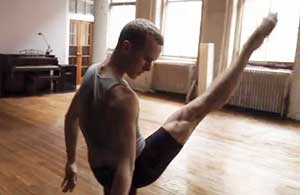 Chip will realize that his sexuality is nothing to be ashamed of and that it is a part of his identity to be embraced. In the end we get to watch them revel together in a joyous mix of camaraderie and playful dance rivalry. It will satisfy anyone who wants a happy ending. But there is also a ridiculously false note - when Chip tells Theo that he wants to introduce him to his mother – that is so at odds with what was established earlier (namely, the screaming mother we heard on the phone several times) that it derails the film. And then, even more abruptly than Test did, Five Dances just ends. But, even if the human story failed to move me, the dance scenes in the rehearsal hall took me to other worlds and that’s where Five Dances really soars. Whenever Chip and Theo dance together the film seems to find its own language and come alive. Much of Five Dances is beautiful, and this may be the best photographed film about dance that I have ever seen. Chip will realize that his sexuality is nothing to be ashamed of and that it is a part of his identity to be embraced. In the end we get to watch them revel together in a joyous mix of camaraderie and playful dance rivalry. It will satisfy anyone who wants a happy ending. But there is also a ridiculously false note - when Chip tells Theo that he wants to introduce him to his mother – that is so at odds with what was established earlier (namely, the screaming mother we heard on the phone several times) that it derails the film. And then, even more abruptly than Test did, Five Dances just ends. But, even if the human story failed to move me, the dance scenes in the rehearsal hall took me to other worlds and that’s where Five Dances really soars. Whenever Chip and Theo dance together the film seems to find its own language and come alive. Much of Five Dances is beautiful, and this may be the best photographed film about dance that I have ever seen.
More on Chris Mason Johnson:
The New Twenty |




